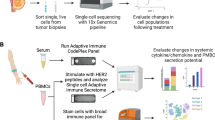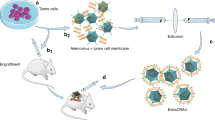Abstract
Inactivated Sendai virus particle (or hemagglutinating virus of Japan envelope; HVJ-E) has been previously reported to possess antitumour properties that activate antitumour immunity. Two glycoproteins, fusion (F) and hemagglutinin-neuraminidase (HN), are present on the surface of HVJ-E. HN is necessary for binding to receptors such as acidic gangliosides, and F induces membrane fusion by associating with membrane lipids. We previously reported that liposomes reconstituted with F but not HN showed antitumour activity by inducing IL-6 secretion in dendritic cells (DCs), suggesting that F protein is capable of eliciting antitumour activity. Here, we attempted to deliver F gene into tumour tissue in mice by electroporation and demonstrated that F gene therapy retarded tumour growth, increased CD4+ and CD8+ T-cell infiltration into tumours and induced tumour-specific IFN-γ T-cell response. However, neutralisation of IL-6R signalling did not impact F plasmid-mediated antitumour effect. Instead, we found that F plasmid treatment resulted in a significant increase in the secretion of the chemokine RANTES (regulated upon activation, normal T cell expressed and secreted) by tumour-infiltrating T cells. Neutralising antibody against RANTES abolished the antitumour effect of F plasmid treatment in a dose-dependent manner. Thus, F gene therapy may show promise as a novel therapeutic for single or combined cancer immunotherapy.
This is a preview of subscription content, access via your institution
Access options
Subscribe to this journal
Receive 12 print issues and online access
$259.00 per year
only $21.58 per issue
Buy this article
- Purchase on Springer Link
- Instant access to full article PDF
Prices may be subject to local taxes which are calculated during checkout





Similar content being viewed by others
References
Olsson SE, Villa LL, Costa RL, Petta CA, Andrade RP, Malm C, et al. Induction of immune memory following administration of a prophylactic quadrivalent human papillomavirus (HPV) types 6/11/16/18 L1 virus-like particle (VLP) vaccine. Vaccine. 2007;25:4931–9.
Petrella T, Quirt I, Verma S, Haynes AE, Charette M, Bak K, et al. Single-agent interleukin-2 in the treatment of metastatic melanoma. Curr Oncol. 2007;14:21–6.
Atkins MB, Lotze MT, Dutcher JP, Fisher RI, Weiss G, Margolin K, et al. High-dose recombinant interleukin 2 therapy for patients with metastatic melanoma: analysis of 270 patients treated between 1985 and 1993. J Clin Oncol. 1999;17:2105–16.
Yang JC, Rosenberg SA. Adoptive T-cell therapy for cancer. Adv Immunol. 2016;130:279–94.
Tumeh PC, Harview CL, Yearley JH, Shintaku IP, Taylor EJ, Robert L, et al. PD-1 blockade induces responses by inhibiting adaptive immune resistance. Nature. 2014;515:568–71.
Luke JJ, Flaherty KT, Ribas A, Long GV. Targeted agents and immunotherapies: optimizing outcomes in melanoma. Nat Rev Clin Oncol. 2017;14:463–82.
Ahmad M, Rees RC, Ali SA. Escape from immunotherapy: possible mechanisms that influence tumor regression/progression. Cancer Immunol Immunother. 2004;53:844–54.
Yang L, Carbone DP. Tumor-host immune interactions and dendritic cell dysfunction. Adv Cancer Res. 2004;92:13–27.
Seliger B. Strategies of tumor immune evasion. BioDrugs. 2005;19:347–54.
Sakaguchi S, Yamaguchi T, Nomura T, Ono M. Regulatory T cells and immune tolerance. Cell. 2008;133:775–87.
Okada Y. Sendai virus-induced cell fusion. Methods Enzymol. 1993;221:18–41.
White JM. Viral and cellular membrane fusion proteins. Annu Rev Physiol. 1990;52:675–97.
Yasuoka E, Oshima K, Tamai K, Kubo T, Kaneda Y. Needleless intranasal administration of HVJ-E containing allergen attenuates experimental allergic rhinitis. J Mol Med (Berl). 2007;85:283–92.
Kaneda Y, Nakajima T, Nishikawa T, Yamamoto S, Ikegami H, Suzuki N, et al. Hemagglutinating virus of Japan (HVJ) envelope vector as a versatile gene delivery system. Mol Ther. 2002;6:219–26.
Oshima K, Shimamura M, Mizuno S, Tamai K, Doi K, Morishita R, et al. Intrathecal injection of HVJ-E containing HGF gene to cerebrospinal fluid can prevent and ameliorate hearing impairment in rats. FASEB J. 2004;18:212–4.
Nakamura H, Aoki M, Tamai K, Oishi M, Ogihara T, Kaneda Y, et al. Prevention and regression of atopic dermatitis by ointment containing NF-kB decoy oligodeoxynucleotides in NC/Nga atopic mouse model. Gene Ther. 2002;9:1221–9.
Ito M, Yamamoto S, Nimura K, Hiraoka K, Tamai K, Kaneda Y. Rad51 siRNA delivered by HVJ envelope vector enhances the anti-cancer effect of cisplatin. J Gene Med. 2005;7:1044–52.
Kurooka M, Kaneda Y. Inactivated Sendai virus particles eradicate tumors by inducing immune responses through blocking regulatory T cells. Cancer Res. 2007;67:227–36.
Suzuki H, Kurooka M, Hiroaki Y, Fujiyoshi Y, Kaneda Y. Sendai virus F glycoprotein induces IL-6 production in dendritic cells in a fusion-independent manner. FEBS Lett. 2008;582:1325–9.
Gotoh B, Ogasawara T, Toyoda T, Inocencio NM, Hamaguchi M, Nagai Y. An endoprotease homologous to the blood clotting factor X as a determinant of viral tropism in chick embryo. EMBO J. 1990;9:4189–95.
Lamb RA. Paramyxovirus fusion: a hypothesis for changes. Virology. 1993;197:1–11.
Iwata S, Schmidt AC, Titani K, Suzuki M, Kido H, Gotoh B, et al. Assignment of disulfide bridges in the fusion glycoprotein of Sendai virus. J Virol. 1994;68:3200–6.
Hoekstra D, Klappe K, Hoff H, Nir S. Mechanism of fusion of Sendai virus: role of hydrophobic interactions and mobility constraints of viral membrane proteins. Effects of polyethylene glycol. J Biol Chem. 1989;264:6786–92.
Ghosh JK, Peisajovich SG, Shai Y. Sendai virus internal fusion peptide: structural and functional characterization and a plausible mode of viral entry inhibition. Biochemistry. 2000;39:11581–92.
Kawachi M, Tamai K, Saga K, Yamazaki T, Fujita H, Shimbo T, et al. Development of tissue-targeting hemagglutinating virus of Japan envelope vector for successful delivery of therapeutic gene to mouse skin. Hum Gene Ther. 2007;18:881–94.
Chuang TH, Lee J, Kline L, Mathison JC, Ulevitch RJ. Toll-like receptor 9 mediates CpG-DNA signaling. J Leukoc Biol. 2002;71:538–44.
Lou Y, Liu C, Lizee G, Peng W, Xu C, Ye Y, et al. Antitumor activity mediated by CpG: the route of administration is critical. J Immunother. 2011;34:279–88.
Sharma RK, Chheda ZS, Jala VR, Haribabu B. Regulation of cytotoxic T-Lymphocyte trafficking to tumors by chemoattractants: implications for immunotherapy. Expert Rev Vaccin. 2015;14:537–49.
Saga K, Tamai K, Yamazaki T, Kaneda Y. Systemic administration of a novel immune-stimulatory pseudovirion suppresses lung metastatic melanoma by regionally enhancing IFN-gamma production. Clin Cancer Res. 2013;19:668–79.
Chang CY, Tai JA, Li S, Nishikawa T, Kaneda Y. Virus-stimulated neutrophils in the tumor microenvironment enhance T cell-mediated anti-tumor immunity. Oncotarget. 2016;7:42195–207.
Castellino F, Huang AY, Altan-Bonnet G, Stoll S, Scheinecker C, Germain RN. Chemokines enhance immunity by guiding naive CD8+ T cells to sites of CD4+ T cell-dendritic cell interaction. Nature. 2006;440:890–5.
Appay V, Rowland-Jones SL. RANTES: a versatile and controversial chemokine. Trends Immunol. 2001;22:83–7.
Aldinucci D, Colombatti A. The inflammatory chemokine CCL5 and cancer progression. Mediat Inflamm. 2014;2014:292376.
Nishikawa T, Tung LY, Kaneda Y. Systemic administration of platelets incorporating inactivated Sendai virus eradicates melanoma in mice. Mol Ther. 2014;22:2046–55.
Gronevik E, von Steyern FV, Kalhovde JM, Tjelle TE, Mathiesen I. Gene expression and immune response kinetics using electroporation-mediated DNA delivery to muscle. J Gene Med. 2005;7:218–27.
Ishikawa H, Takano M, Matsumoto N, Sawada H, Ide C, Mimura O, et al. Effect of GDNF gene transfer into axotomized retinal ganglion cells using in vivo electroporation with a contact lens-type electrode. Gene Ther. 2004;12:289.
Yu JW, Bhattacharya S, Yanamandra N, Kilian D, Shi H, Yadavilli S, et al. Tumor-immune profiling of murine syngeneic tumor models as a framework to guide mechanistic studies and predict therapy response in distinct tumor microenvironments. PLoS ONE. 2018;13:e0206223.
Kawaguchi Y, Miyamoto Y, Inoue T, Kaneda Y. Efficient eradication of hormone-resistant human prostate cancers by inactivated Sendai virus particle. Int J Cancer. 2009;124:2478–87.
Liu LW, Nishikawa T, Kaneda Y. An RNA molecule derived from Sendai virus DI particles induces antitumor immunity and cancer cell-selective apoptosis. Mol Ther. 2016;24:135–45.
Barber GN. STING-dependent cytosolic DNA sensing pathways. Trends Immunol. 2014;35:88–93.
Li Y, Wilson HL, Kiss-Toth E. Regulating STING in health and disease. J Inflamm. 2017;14:11.
Abe T, Barber GN. Cytosolic-DNA-mediated, STING-dependent proinflammatory gene induction necessitates canonical NF-kappaB activation through TBK1. J Virol. 2014;88:5328–41.
An X, Zhu Y, Zheng T, Wang G, Zhang M, Li J, et al. An analysis of the expression and association with immune cell infiltration of the cGAS/STING pathway in pan-cancer. Mol Ther Nucleic Acids. 2019;14:80–9.
Larkin B, Ilyukha V, Sorokin M, Buzdin A, Vannier E, Poltorak A. Cutting edge: activation of STING in T cells induces type I IFN responses and cell death. J Immunol. 2017;199:397–402.
Cerboni S, Jeremiah N, Gentili M, Gehrmann U, Conrad C, Stolzenberg MC, et al. Intrinsic antiproliferative activity of the innate sensor STING in T lymphocytes. J Exp Med. 2017;214:1769–85.
Acknowledgements
We thank Kotaro Saga for providing the pCY4B and pCY4B-F plasmids. The authors received donations from Ishihara Sangyo Kaisha, Ltd. and Stemrim, Inc. for the research of this article.
Author information
Authors and Affiliations
Corresponding author
Ethics declarations
Conflict of interest
The authors declare that they have no conflict of interest.
Additional information
Publisher’s note: Springer Nature remains neutral with regard to jurisdictional claims in published maps and institutional affiliations.
Supplementary information
Rights and permissions
About this article
Cite this article
Tai, J.A., Chang, C.Y., Nishikawa, T. et al. Cancer immunotherapy using the Fusion gene of Sendai virus. Cancer Gene Ther 27, 498–508 (2020). https://doi.org/10.1038/s41417-019-0126-6
Received:
Revised:
Accepted:
Published:
Issue Date:
DOI: https://doi.org/10.1038/s41417-019-0126-6



